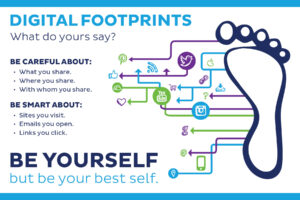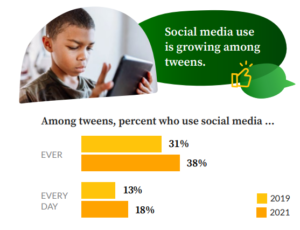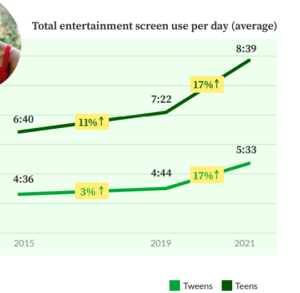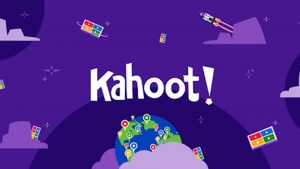 Technology has most certainly engrained itself in the present lives of our youths. Teens are becoming more and more dependent on technology and we can not deny that there is a fascination among our youths today that is centered around social media. A huge part of how teens interact with one another nowadays is linked to the use of different social media platforms and the accessibility to information has been ramped up by technology. People are using social media to communicate, share, connect, and even advocate for one another. We are seeing more people advocating for different social justice issues online and taking a stance on a variety of topics. We can not dispute that “ technology is accelerating the rate at which ideas, relationships, and information are shared and that mass distribution [as well as] the ability to effortlessly share information has influenced many facets of modern life, changing the way we think about, connect to, and engage with social justice and activism” (Marville University, 2023). With the increase in the use of technology, educators are now left pondering whether they have a responsibility to use technology and social media to promote social justice.
Technology has most certainly engrained itself in the present lives of our youths. Teens are becoming more and more dependent on technology and we can not deny that there is a fascination among our youths today that is centered around social media. A huge part of how teens interact with one another nowadays is linked to the use of different social media platforms and the accessibility to information has been ramped up by technology. People are using social media to communicate, share, connect, and even advocate for one another. We are seeing more people advocating for different social justice issues online and taking a stance on a variety of topics. We can not dispute that “ technology is accelerating the rate at which ideas, relationships, and information are shared and that mass distribution [as well as] the ability to effortlessly share information has influenced many facets of modern life, changing the way we think about, connect to, and engage with social justice and activism” (Marville University, 2023). With the increase in the use of technology, educators are now left pondering whether they have a responsibility to use technology and social media to promote social justice.
 While finishing my undergraduate degree, it was voiced by many professors and colleagues that I should be careful with what I chose to share on social media with others and it was stressed that privacy could be hard to attain because we were continuously in the public eye. I quickly came to understand that educators are held to a high standard and every little thing we say or do is being analyzed and critiqued by the public. Every school year I have students that tell me upon meeting me that they or their parents went searching for me on social media and on the internet; some of them do a deep dive and will pull up information that I had even forgotten about or was not aware was somewhere online. Part of me can sympathize with parents that are curious to get to know their child’s teacher and make sure they are responsible citizens. However, there is another part of me that feels exposed and vulnerable because I can not have a little more privacy in my daily life. It is also very common to run into students/families when doing different errands or going out for supper with friends and family, thus educators need to be mindful of their behaviour as well as how they portray themselves when they are out and about. It seems that educators are often being observed underneath a magnifying glass and any stance we take on differing issues is ready to be highlighted.
While finishing my undergraduate degree, it was voiced by many professors and colleagues that I should be careful with what I chose to share on social media with others and it was stressed that privacy could be hard to attain because we were continuously in the public eye. I quickly came to understand that educators are held to a high standard and every little thing we say or do is being analyzed and critiqued by the public. Every school year I have students that tell me upon meeting me that they or their parents went searching for me on social media and on the internet; some of them do a deep dive and will pull up information that I had even forgotten about or was not aware was somewhere online. Part of me can sympathize with parents that are curious to get to know their child’s teacher and make sure they are responsible citizens. However, there is another part of me that feels exposed and vulnerable because I can not have a little more privacy in my daily life. It is also very common to run into students/families when doing different errands or going out for supper with friends and family, thus educators need to be mindful of their behaviour as well as how they portray themselves when they are out and about. It seems that educators are often being observed underneath a magnifying glass and any stance we take on differing issues is ready to be highlighted.
At the beginning of my career, I was very concerned that parents would think I had an agenda when it came to the different topics I taught in class; this was particularly true when it came to any controversial topics that were taught in the classroom. As a woman pertaining to a racialized group, I had this fear that parents would think I was teaching with an agenda in mind – especially when we discussed issues of race or topics relating to Truth and Reconciliation. I would even triple-check to make sure what I was teaching reflected the outcomes in the curriculum. Additionally, I made certain that my administration was on board with what I was teaching and was always aware of the different topics being discussed in class. Having my administration back me up was reassuring and gave me the confidence to discuss controversial topics freely in my classroom. As a new teacher, I recall it was important for me to remain “neutral” on a variety of topics – in retrospect, I can link this feeling of uncertainty about what was appropriate to teach in the classroom to a fear of backlash and inexperience.
 Now that I have more experience teaching, I have come to understand that teachers hold power and infinite amounts of responsibility. I believe it is our job to teach our students to act responsibly and think critically for themselves. On many occasions, we use the classroom as a starting point to discuss controversial topics and it is in the classroom where we pass on various morals and values to students that we hope will make them better overall human beings in the future. From a young age, we teach children at school that we do not lie, we do not steal, we do not hit/hurt others and we treat others how we would like to be treated. We discuss the concept of bullying and intimidation and teach students to embrace the concept of acceptance while celebrating our differences and unique attributes. Additionally, we teach students to not only respect others but to also take a stand when injustices are taking place; we also strive to ensure our students show empathy and compassion for others. Educators do all this in a guiding manner to help students reach these outcomes of their own volition.
Now that I have more experience teaching, I have come to understand that teachers hold power and infinite amounts of responsibility. I believe it is our job to teach our students to act responsibly and think critically for themselves. On many occasions, we use the classroom as a starting point to discuss controversial topics and it is in the classroom where we pass on various morals and values to students that we hope will make them better overall human beings in the future. From a young age, we teach children at school that we do not lie, we do not steal, we do not hit/hurt others and we treat others how we would like to be treated. We discuss the concept of bullying and intimidation and teach students to embrace the concept of acceptance while celebrating our differences and unique attributes. Additionally, we teach students to not only respect others but to also take a stand when injustices are taking place; we also strive to ensure our students show empathy and compassion for others. Educators do all this in a guiding manner to help students reach these outcomes of their own volition.
 I believe that educators can discuss controversial subjects with their students while voicing their stance on the issues at hand. The trick is to create a safe classroom environment where students feel they can express themselves wholeheartedly without fear of repercussions and that all students feel like their voices are being heard as well as their contributions in class discussions are valued. I feel strongly that educators have the responsibility to teach for social justice in their classrooms – especially considering the times we are currently living in. Furthermore, I consider the use of social media to introduce different instances of social justice taking place worldwide an excellent alternative.
I believe that educators can discuss controversial subjects with their students while voicing their stance on the issues at hand. The trick is to create a safe classroom environment where students feel they can express themselves wholeheartedly without fear of repercussions and that all students feel like their voices are being heard as well as their contributions in class discussions are valued. I feel strongly that educators have the responsibility to teach for social justice in their classrooms – especially considering the times we are currently living in. Furthermore, I consider the use of social media to introduce different instances of social justice taking place worldwide an excellent alternative.
“Social media has provided a dynamic avenue for activists to spread their messages and reach a wider audience on the global stage… [Social media provides a] sense of togetherness and collective consciousness allows individuals to be seen and to be heard by others and encourages people to share their own stories without fear of judgment or that they are alone in their struggles” (Gehr, 2021).
Taking into consideration the huge role social media plays in our students’ day-to-day life, I think it would be wise that we use this avenue to promote social justice initiatives while building on the sense of community.
 In today’s class, we discussed the fact that teachers hold a lot of power and thus, have control over what we consider a priority – what is important – in our classrooms. There is no doubt that technology has become quite predominant in education over the past couple of decades. As educators strive to remain innovative, engaging, and relevant in their profession, technology has become a tool that allows them to reach these goals when teaching their students. I do not believe anyone in the education sector is questioning the relevance of using technology in the classroom. However, as we examined in class today, there is a question pertaining to the role educators play when introducing different technologies to their students; more precisely, are we as educators responsible for teaching our students to act accordingly online while helping them establish a digital footprint?
In today’s class, we discussed the fact that teachers hold a lot of power and thus, have control over what we consider a priority – what is important – in our classrooms. There is no doubt that technology has become quite predominant in education over the past couple of decades. As educators strive to remain innovative, engaging, and relevant in their profession, technology has become a tool that allows them to reach these goals when teaching their students. I do not believe anyone in the education sector is questioning the relevance of using technology in the classroom. However, as we examined in class today, there is a question pertaining to the role educators play when introducing different technologies to their students; more precisely, are we as educators responsible for teaching our students to act accordingly online while helping them establish a digital footprint?





 Social media has developed into something quite powerful and predominant in the lives of youth nowadays. These digital natives born in an era where they are surrounded by technology, rely heavily on social media as a way to stay connected and informed. Almost all teens have some form of social media they are signed up to use and we can attest to the fact that they use it regularly. Instagram, Snapchat, TikTok and Facebook seem to be among some of the more popular platforms; watching online videos is also ranked as a favourite pastime for both tweens and teens (
Social media has developed into something quite powerful and predominant in the lives of youth nowadays. These digital natives born in an era where they are surrounded by technology, rely heavily on social media as a way to stay connected and informed. Almost all teens have some form of social media they are signed up to use and we can attest to the fact that they use it regularly. Instagram, Snapchat, TikTok and Facebook seem to be among some of the more popular platforms; watching online videos is also ranked as a favourite pastime for both tweens and teens (



 As an educator, I use technology with my students on a daily basis to enhance their learning and enrich my teaching. For example, we use a projector daily so that my kiddos can follow along and stay focused on our lessons. I use PowerPoint and Canva to create visual-aid tools for my students in French. I also use YouTube and the internet to gain access to teaching resources in French – which in the past used to be harder to find and the selection of resources was very limited and at times outdated. Furthermore, I love using different educational apps – such as Kahoot or Quizlet – as assessment tools in our classroom to track the kiddos’ progress and assess their level of understanding. I also use Boom Cards to introduce new concepts/vocabulary to my students in French and I am a big fan of creating QR codes to support literacy and numeracy centers in my classroom which turns our classroom iPads into digital workbooks. For me, it is a no-brainer and I full-heartedly believe technology enhances our students’ learning in the classroom. I will say though that if you choose to integrate technology into your teaching, you need to ensure that you are preparing your material (and testing it out) ahead of time and finding ways to incorporate technology in meaningful ways that will further your students’ learning. We can not just use technology for the sake of saying we use it – technology needs to be integrated into our teaching with purpose so that our students can get the most out of it and they can enhance their learning through the use of technology.
As an educator, I use technology with my students on a daily basis to enhance their learning and enrich my teaching. For example, we use a projector daily so that my kiddos can follow along and stay focused on our lessons. I use PowerPoint and Canva to create visual-aid tools for my students in French. I also use YouTube and the internet to gain access to teaching resources in French – which in the past used to be harder to find and the selection of resources was very limited and at times outdated. Furthermore, I love using different educational apps – such as Kahoot or Quizlet – as assessment tools in our classroom to track the kiddos’ progress and assess their level of understanding. I also use Boom Cards to introduce new concepts/vocabulary to my students in French and I am a big fan of creating QR codes to support literacy and numeracy centers in my classroom which turns our classroom iPads into digital workbooks. For me, it is a no-brainer and I full-heartedly believe technology enhances our students’ learning in the classroom. I will say though that if you choose to integrate technology into your teaching, you need to ensure that you are preparing your material (and testing it out) ahead of time and finding ways to incorporate technology in meaningful ways that will further your students’ learning. We can not just use technology for the sake of saying we use it – technology needs to be integrated into our teaching with purpose so that our students can get the most out of it and they can enhance their learning through the use of technology.

 ). I still have lots to learn when it comes to this technology, but I am motivated to continue to use this virtual classroom I set up with my kiddos. I will say you can defintely take hours playing around with setting up a virtual classroom and there’s many possibilities to what you can include in your virtual classroom. Just “start the slideshow”, then look for my Bitmoji and click on it on each slide to get started and be redirected to a video presentation. When you make it to the different “Group Presentations” (starting on Slide 7), click on the notebooks for reading material and click on the “laptop” for videos. Once you make it to the last slide in the slideshow, you will have different logos of different technology you can use in the classroom or with your students – if you click on the logos, you will be redirected to the appropriate websites. Thank you Katia for a wonderful and informative semester and thanks to everyone in this class for being part of my tech journey and allowing me to be a part of yours! I hope our paths will cross again at some point!
). I still have lots to learn when it comes to this technology, but I am motivated to continue to use this virtual classroom I set up with my kiddos. I will say you can defintely take hours playing around with setting up a virtual classroom and there’s many possibilities to what you can include in your virtual classroom. Just “start the slideshow”, then look for my Bitmoji and click on it on each slide to get started and be redirected to a video presentation. When you make it to the different “Group Presentations” (starting on Slide 7), click on the notebooks for reading material and click on the “laptop” for videos. Once you make it to the last slide in the slideshow, you will have different logos of different technology you can use in the classroom or with your students – if you click on the logos, you will be redirected to the appropriate websites. Thank you Katia for a wonderful and informative semester and thanks to everyone in this class for being part of my tech journey and allowing me to be a part of yours! I hope our paths will cross again at some point! 